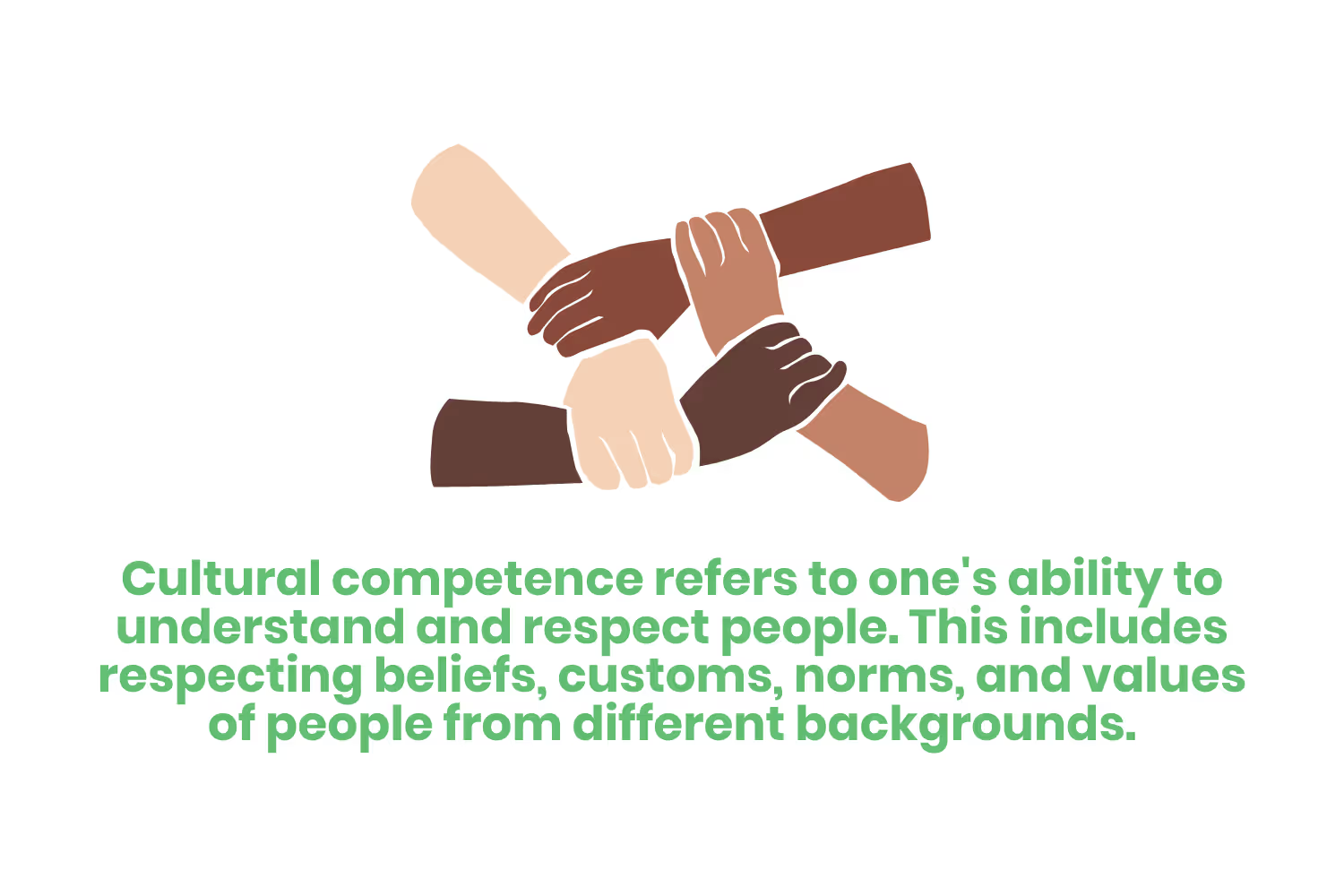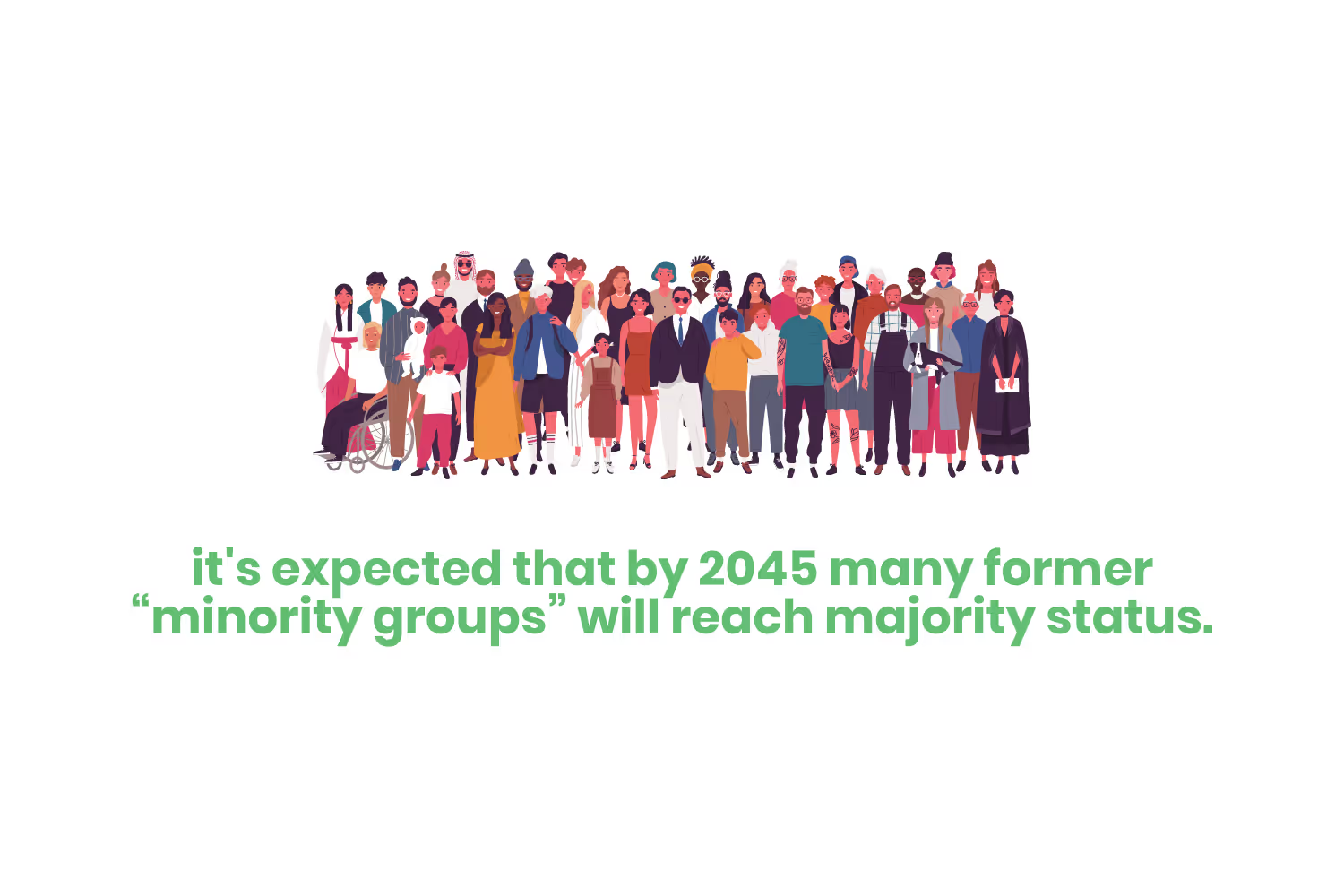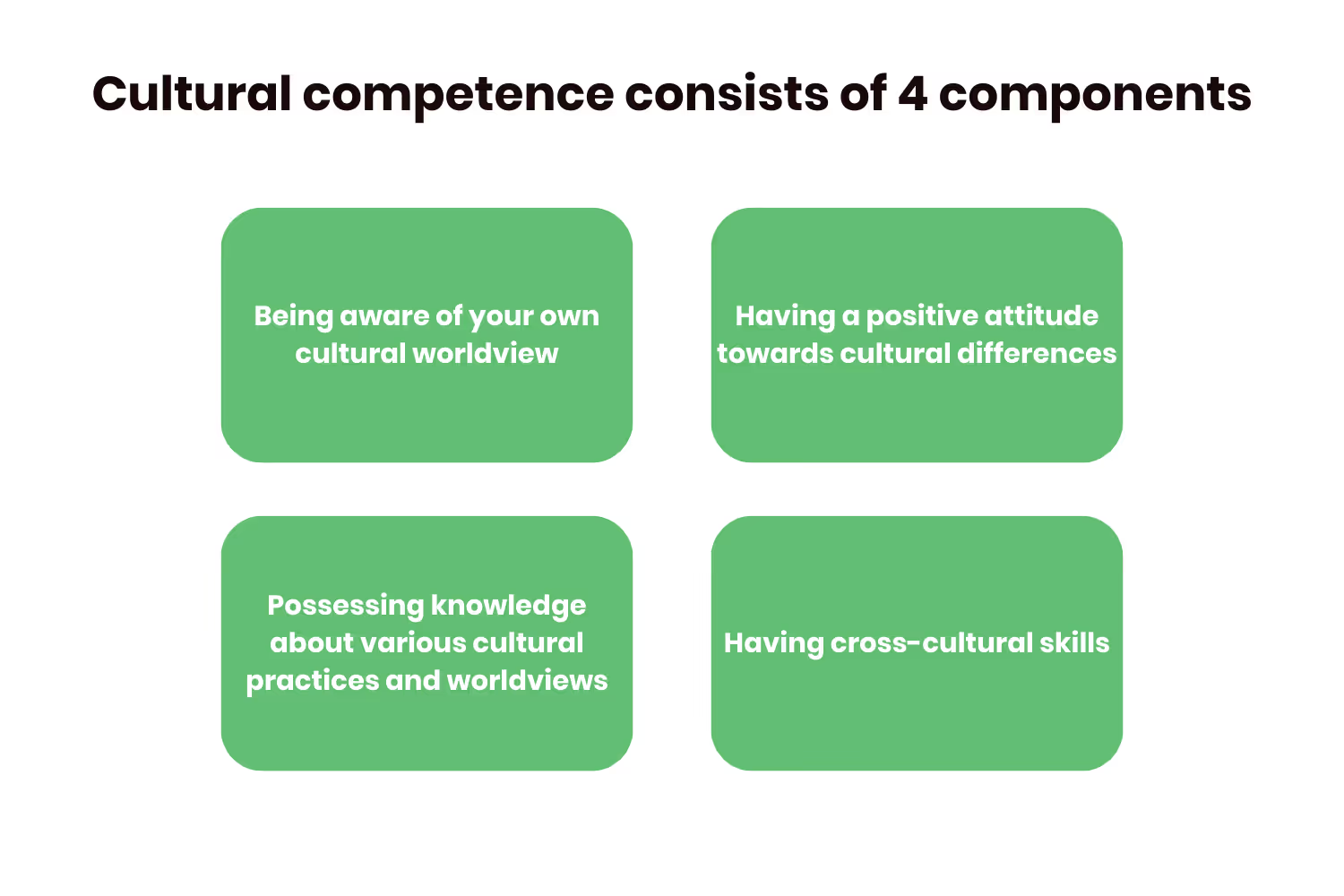45+ Examples of Cultural Competence in The Workplace
You see, fostering an inclusive workplace culture is more of a requirement than not in this modern business world. And the best way to learn how to instill such a workplace is through examples. So, let’s go through over 45 different examples of cultural competence.

Culturally diverse companies perform 36% better financially than less diverse businesses.
That statistic puts the importance of having a culturally competent workforce into simple terms. If your organization is diverse, it will perform better.
In other words, no one can deny the importance of fostering an inclusive workplace. Hiring a diverse group of people is only one aspect that sets a company up for the success of that statistic, though.

If and/or when you hire a diverse workgroup, it’s very possible that that talent pool comes from different cultures. Thus, those employees might have different norms than the “majority” of society. If your organization doesn’t respect the norms and/or culture of the diverse group of employees you hire, they’re going to leave.
I don’t blame them, do you? Imagine coming into a job every day not feeling part of the organization because your beliefs aren’t accepted?
The reality is that cultural incompetence played out in the workplace often leads to lawsuits with massive payouts. Most organizations that let this incompetence fester among their workforce end up in a lawsuit situation. Yet, they hade the opportunity to prevent it from happening all along.
You see, fostering an inclusive workplace culture is more of a requirement than not in this modern business world. And the best way to learn how to instill such a workplace is through examples. So, let’s go through over 45 different examples of cultural competence.
Definition of Cultural Competence
Cultural competence is simple. It refers to one's ability to understand and respect people. This includes respecting beliefs, customs, norms, and values of people from different backgrounds. It also means having the ability to socialize with people who are from a different cultural background for yourself.
You can do this by developing skills that genuinely seek communication and understanding. Such skills include reading emotion and positive attitudes
Cultural competence helps you respect and appreciate the diversity of human experiences. It allows you to create inclusive environments that support the needs of diverse populations.
Generally speaking, cultural competence improves with experience. Interactions with people from different backgrounds represent opportunities in increase your culture competence.
There are three components to cultural competence: cognitive, affective, and behavioral components.

The cognitive component of cultural competence involves developing knowledge about different cultures. You need to be aware of different…
- Cultural worldviews
- Belief systems
- History
- Traditions
- Practices
- Language
This also includes understanding how culture influences behavior attitudes towards…
- Healthcare services
- Education
- Work
- Politics
- Perceptions of time and space
- Communications
- Relationships
The affective component involves developing empathy for those of different cultures. This happens by recognizing and respecting their perspectives without imposing our own beliefs. You need to have an open mind towards diversity in order to learn more about other’s perspectives.
The behavioral part means adapting your communication style based on the specific context of the situation. This shows interest in what others have to say while being aware of power dynamics between different groups. This includes respecting boundaries within which individuals feel comfortable expressing themselves easily.
Examples of Cultural Competence
Cultural competence is an important aspect to your everyday life, but where does its effects have the most impact? At your job, of course! You see, the modern day business landscape also happens to be where various cultures converge the most.
In fact, it's expected that by 2045 many former “minority groups” will reach majority status.
In other words, you’re soon going to be walking into an office filled with people from different corners of the world. And each of those people will have different customs, values and etiquette.
Although that’s no doubt exciting, you’ll still have collective jobs to do. So, how do you ensure the completion of company projects while fostering an inclusive environment?

By educating yourself, of course!
The following are examples of how cultural competence comes into play when interacting with people around you.
- Picking up a few words of the local language while traveling abroad to try and show some respect to the local culture.
- Learning about other languages, including their communication styles and styles of expression
- Understanding social norms from different cultures.
- Avoiding making assumptions about people based on how they look or elements of their identity, such as ethnicity.
- Being empathetic when a menu confuses a patron and norms of local dining etiquette.
- Acknowledging and appreciating differences in communication styles across cultures.
- A traveler speaking slowly in English while in a non-english speaking environment.
- A government document in plain language to help make the information more broadly accessible.
- A textbook author who avoids cultural and lifestyle assumptions in the wording of examples to illustrate a learning objective.
- Identifying and defeating one’s own bias in dealing with individuals with different backgrounds and identities.
- Seeking relationships with people from diverse backgrounds to build understanding and empathy for different cultures.
- Someone working with a minority group and action reads about the minority’s cultural practices.
- Learning about alternate perspectives and practices.
- Asking questions to carefully understand each individual as opposed to making assumptions based on cultural stereotypes.
- Establishing rapport with customers from different nations, carefully trying to understand each person as an individual and relate to them and their motivations, values, and sense of humor.
- Respecting and celebrating diversity and appreciate the richness of different backgrounds and experiences
- A traveler who becomes skilled at communicating with gestures, facial expressions, body language , eye contact, tone of voice, drawings, and basic vocabulary.
- Being a member of multiple cultures in such a way that you enjoy extended cultural capital.
- Offering services that cater specifically to a particular population group.
- An individual who speaks several languages well enough such that they can communicate with a large number of people in their native language.
- Reading about other cultures but still being careful not to make assumptions about people.
- Appreciating different eating habits.
- An international student who makes friends with people that have different backgrounds instead of clinging to those with the same background.
- A student who makes friends with international students and works to engage them in local culture and community.
- Respecting others’ religious beliefs and spiritual practices
- A foreigner living in a country for many years who isn't affected by locals making inaccurate assumptions about the foreigner.
- Someone who is happy to explain when another person is genuinely curious about their culture.
- A business who regularly trains staff in cultural competence in such a way that employees study key cultural differences.
Examples of Cultural Incompetence
Of course, part of the learning process associated with cultural competence is also knowing the opposite.
Let’s say you’re “on the road of collaboration.” In this metaphor, potholes that hinder progress along the way are cultural misunderstandings. You’ll either have to slow down or risk going over them and getting a flat tire. Not good.

The reality is that cultural incompetence causes discomfort and misunderstandings while hindering progress.
Let’s shed some light on how cultural incompetence can manifest itself in workplace scenarios.
- A tourist speaks their mother tongue in a foreign country and becomes annoyed when the locals don’t understand or are “rude” in response.
- Causing people to lose face in a culture where this isn’t the norm.
- Explaining something in an obscure manner so that only people with a similar cultural background as yourself will understand.
- Being hostile to people speaking your language because you are impatient with their accent.
- Assuming a customer can’t speak the local language because of their skin color.
- Trying to convey how much you know about another person’s culture to the point you come off as presumptuous and boorish.
- An individual who makes assumptions about someone based on their culture.
- Applying or stating stereotypes and biases based on culture.
- Being insensitive or unaware of differences in culture that are relevant to your job.
- Communicating in such a way that someone perceives as hostile, mocking, generally insulting, or discriminatory.
- Avoiding people from different cultures
- Adoption of an “us vs them” view of other cultures that makes you prone to becoming hostile or unfair.
- Using unnecessarily complex language.
- Trying to sideline someone in a meeting because of their cultural background.
- Becoming self-righteous and angry when someone makes an incorrect assumption about you.
- Failing to treat people as unique individuals when they are from a different culture than yourself.
- Being a know-it-all about someone else’s culture.
- Generally failing to have a positive attitude towards someone based on their culture.
Components of Cultural Competence
Cultural competence consists of four components…
- Being aware of your own cultural worldview
- Having a positive attitude towards cultural differences
- Possessing knowledge about various cultural practices and worldviews
- Having cross-cultural skills
Let’s take a closer look…

1. Awareness of One's Cultural Worldview
Self awareness is the first component of cultural competence. It involves being conscious and reflective about one’s own cultural values, beliefs, and biases.
It also requires someone to understand how their own perspectives change due to their…
- Upbringing
- Experiences
- Socialization
Awareness of one’s cultural worldviews allows people to recognize that other cultures may have different values and beliefs. This creates an opportunity for greater understanding and empathy towards others.
2. Attitude Towards Cultural Differences
The second component of cultural competence is being aware that many cultures have different beliefs, social norms, and practices.
Cultural competence allows us to create attitudes of positive acknowledge. Thus, we understand the value of those differences as opportunities to learn from one another.
A positive attitude towards diversity allows culturally competent people to embrace different customs. They are able to do this while respecting others' lifestyles and traditions.
3. Knowledge of Different Cultural Prfactices and Worldviews
The third component of cultural competence involves acquiring knowledge about different cultures’...
- Habits
- Traditions
- Ways of life
You do this by conducting research or interacting closely with people from those backgrounds.
This includes learning about key aspects. These aspects include language, religion, customs, and values that differ amongst various communities.
Equipped with this knowledge, people can possess a broader view of the world. Thus allowing them to communicate more effectively across diverse groups.
4. Cross-Cultural Skills
The fourth component involves applying all three previous factors. Thus allow you to interact effectively across cultures. This applies to work situations or daily interactions, fostering increased understanding.
This means possessing cross-cultural communication skills enable clear and effective communication. This is true when working with colleagues worldwide or when traveling.
Culturally competent people have the ability to interpret body language cues, tone, and empathize through active listening.
These skills give them a valuable advantage in diverse environments. It sets people apart and makes them desirable candidates for job opportunites.
Conclusion
In today's diverse and fast-paced world, cultural competence is a crucial skill.
As communities become increasingly multicultural, effectively interacting with diverse cultures is a must. This will help build relationships and succeed both personally and professionally.
Culturally competent individuals possess many skills, including…
- Active listening
- Open-mindedness
- Empathy
- Language proficiency
- Non-verbal communication awareness
These skills enable people to celebrate diversity. It also helps them avoid unintentional prejudice or stereotyping.
Improving your own cultural competence is a continuous process. It requires conscious effort and dedication by individuals seeking personal growth. Such people want to be part of becoming a global citizen marked by inclusivity.
From a workplace perspective, training is the answer. Employers should assign workplace diversity training to instill an inclusive culture.
Emphasize your product's unique features or benefits to differentiate it from competitors
In nec dictum adipiscing pharetra enim etiam scelerisque dolor purus ipsum egestas cursus vulputate arcu egestas ut eu sed mollis consectetur mattis pharetra curabitur et maecenas in mattis fames consectetur ipsum quis risus mauris aliquam ornare nisl purus at ipsum nulla accumsan consectetur vestibulum suspendisse aliquam condimentum scelerisque lacinia pellentesque vestibulum condimentum turpis ligula pharetra dictum sapien facilisis sapien at sagittis et cursus congue.
- Pharetra curabitur et maecenas in mattis fames consectetur ipsum quis risus.
- Justo urna nisi auctor consequat consectetur dolor lectus blandit.
- Eget egestas volutpat lacinia vestibulum vitae mattis hendrerit.
- Ornare elit odio tellus orci bibendum dictum id sem congue enim amet diam.
Incorporate statistics or specific numbers to highlight the effectiveness or popularity of your offering
Convallis pellentesque ullamcorper sapien sed tristique fermentum proin amet quam tincidunt feugiat vitae neque quisque odio ut pellentesque ac mauris eget lectus. Pretium arcu turpis lacus sapien sit at eu sapien duis magna nunc nibh nam non ut nibh ultrices ultrices elementum egestas enim nisl sed cursus pellentesque sit dignissim enim euismod sit et convallis sed pelis viverra quam at nisl sit pharetra enim nisl nec vestibulum posuere in volutpat sed blandit neque risus.

Use time-sensitive language to encourage immediate action, such as "Limited Time Offer
Feugiat vitae neque quisque odio ut pellentesque ac mauris eget lectus. Pretium arcu turpis lacus sapien sit at eu sapien duis magna nunc nibh nam non ut nibh ultrices ultrices elementum egestas enim nisl sed cursus pellentesque sit dignissim enim euismod sit et convallis sed pelis viverra quam at nisl sit pharetra enim nisl nec vestibulum posuere in volutpat sed blandit neque risus.
- Pharetra curabitur et maecenas in mattis fames consectetur ipsum quis risus.
- Justo urna nisi auctor consequat consectetur dolor lectus blandit.
- Eget egestas volutpat lacinia vestibulum vitae mattis hendrerit.
- Ornare elit odio tellus orci bibendum dictum id sem congue enim amet diam.
Address customer pain points directly by showing how your product solves their problems
Feugiat vitae neque quisque odio ut pellentesque ac mauris eget lectus. Pretium arcu turpis lacus sapien sit at eu sapien duis magna nunc nibh nam non ut nibh ultrices ultrices elementum egestas enim nisl sed cursus pellentesque sit dignissim enim euismod sit et convallis sed pelis viverra quam at nisl sit pharetra enim nisl nec vestibulum posuere in volutpat sed blandit neque risus.
Vel etiam vel amet aenean eget in habitasse nunc duis tellus sem turpis risus aliquam ac volutpat tellus eu faucibus ullamcorper.
Tailor titles to your ideal customer segment using phrases like "Designed for Busy Professionals
Sed pretium id nibh id sit felis vitae volutpat volutpat adipiscing at sodales neque lectus mi phasellus commodo at elit suspendisse ornare faucibus lectus purus viverra in nec aliquet commodo et sed sed nisi tempor mi pellentesque arcu viverra pretium duis enim vulputate dignissim etiam ultrices vitae neque urna proin nibh diam turpis augue lacus.




